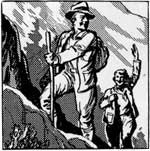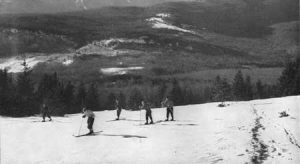WINTER SPORTS AND OTHER PASTIMES
 FOR years the winter us of the national forests of the North and West was one of snow bound isolation—but no longer! The great national-forest snowfields—from the White Mountains of New England across the Lake States, throughout the Rockies from Canada to Mexico, and westward through the Cascades and Sierras—now attract tens of thousands of ski, snowshoe, and toboggan enthusiasts each year. Snow conditions have been found to be ideal, and in certain of the high western forests the season lasts from early fall to August. In some places, as in the Southwest, snow trails in the high mountains of the forests are within 2 or 3 hours' drive of warm winter resorts.
FOR years the winter us of the national forests of the North and West was one of snow bound isolation—but no longer! The great national-forest snowfields—from the White Mountains of New England across the Lake States, throughout the Rockies from Canada to Mexico, and westward through the Cascades and Sierras—now attract tens of thousands of ski, snowshoe, and toboggan enthusiasts each year. Snow conditions have been found to be ideal, and in certain of the high western forests the season lasts from early fall to August. In some places, as in the Southwest, snow trails in the high mountains of the forests are within 2 or 3 hours' drive of warm winter resorts.
Within or in close proximity to the national forests are many of the most famous winter sports centers in the United States—among them Tuckerman Ravine in the White Mountain National Forest of New Hampshire, Sun Valley in Idaho, and Mount Hood in Oregon. The national forests have abundant snow trails suited to the winter sports beginner as well as to the expert. In some places the Forest Service has provided shelters and, in occasional instances, ski lifts as well. Much clearing and marking of downhill runs and cross country trails has been done to facilitate both sport and personal safety.

Whether expert or beginner, there is a place for you on the abundant ski trails and open slopes in the national forests.—White Mountain National Forest, N. H. (F—361307)
Of all outdoor sports mountain climbing is perhaps the most vigorous, fascinating, and oftentimes most dangerous. National forests number among their many mountains most of the highest and most precipitous peaks in America. A few of them are difficult enough to defy the attempts of even the most expert climbers.
For the camera hunter the national forests with their well-nigh unlimited scenic views and variety of wildlife and colorful outdoor sports offer untold opportunities. Naturalists will find in the isolation and primitive conditions of the wilderness areas a fertile field for study and discovery.
In unexplored caves, outcropping rock oddities, and fossil deposits of wide variety there is much to attract the attention of the geologist. The botanist has a range from the strange Cranberry Glades of West Virginia to the great rain forests of the Pacific Northwest, and from the rare flowers of alpine meadows of the Northwest to the scrub-pine thickets of the South. And for the amateur mineralogist and prospector the national forests furnish an almost limitless field for exploration.

